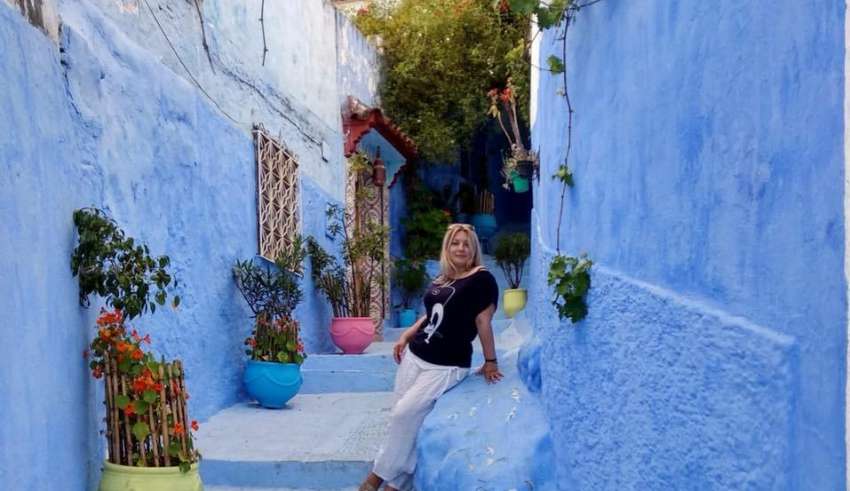
By Oksana Starostina
Our world is multifaceted! I always admire it and suggest everyone to travel. My advice is a perceived traveling with the goal of understanding how the world works, studying the cultural traditions of different nationalities of the world and with the aim of understanding the mentality of certain ethnographic groupы, and also with the purpose of studying history. After all, you will agree, it is much more informative to touch the gray stones of an ancient temple with your own hands than to hear about it a thousand times.
I visited more than 30 countries for my life, somewhere I lived, and somewhere I was with the purpose of business, somewhere with the purpose of tourism. However, always and everywhere I was amazed by what we are different and at the same time similar to each other.
For now, I have been working with the countries of M.E.N.A. for more than 8 years. I love this region and I already know a lot about it, I have many friends and partners from these regions and today I understand one thing: Europe does not know anything about the Arab world except what was written in tourist brochures. For the average Ukrainian, all the peoples inhabiting the Middle East and North Africa are the Arabs. Nobody knows that there are 21 countries in this region, where their own laws operate, culture differs and a big variety of different nations inhabit it. This is a gross error, which allowed not only by my compatriots, but also by all Europeans in most cases.
My utopian idea is to make a bridge between two different cultures and show my compatriots and subscribers from other countries the beauty of the east and its diversity. Discovering new horizons, I gladly share this on my social networking pages. I understand that it sounds a little utopian, but I believe that there are thinking and reading people who are interested in this topic. I think that the time of ignorance has passed and a person today should be a cosmopolitan, and to know that we are surrounded a bit deeper than man did in the last century. My life project is to popularize deep knowledge about other nations and debunk myths about the Middle East and North African countries, and at the same time fight against stereotypes. The Arab world is extremely huge and diverse. Accordingly, both the way of life and customs in different localities differ markedly. I wanted to show and tell about these differences.
Recently I decided to tell the world about the glorious country of Morocco. I made a route that consisted of 3000 km across Morocco to see how the city lives and how the village lives, to visit the most ancient places, to be acquainted with the culture and peoples that inhabit this country, to see the desert and the ocean, to cross the Atlas Mountains and study art and crafts of indigenous peoples.
I read a lot of information about this country, but what I saw when I came there was much deeper and more alive than any article on the Internet. I was also inspired by the book “Arts and Crafts of Morocco” by Dr. James F. Jereb and one of the purposes of this journey was to study the arts and crafts of this country. The amazing arts and crafts of Morocco express a centuries-long intermingling of influences from both Africa and Islam, and from the spectacular cultural alliance of the Moors and the Spaniards. Yet despite their versatility and diversity, Moroccan crafts are still little known outside the country.
Dr. James F. Jereb’s pioneering account based on his own first-hand research, examines all the media one by one: vibrantly colored textiles; jewelry in myriad forms and exquisite configurations; leather, wood and metalwork of great originality; and enormous variety of pottery and ceramics. All this I wanted to investigate on my own, to see how they do it and to understand why they are so different from other Arabic countries.
My route was designed to travel 3000 km in 17 Days, stopping in places that would interest me both as a researcher and as a person who simply loves this planet to enjoy village and city life, communicate to different people and make new friends of different professions and interests.
In my narrative, I will focus only on those places that are most memorable and startling, leaving in my heart the warmest memories.
Therefore, the route began in Casablanca, where we flew in and rented a car.
Casablanca
Casablanca is a port and business city on the Atlantic coast in western Morocco. The city is famous for buildings built during the reign of the French in the style of the sea, which combines the Moorish architectural traditions and elements of the European Art Deco. The huge mosque of Hasan II, whose construction was completed in 1993, is partially located above the Atlantic Ocean. In the upper part of its minaret, which soars for 210 meters, a laser is installed, the beam of which is directed towards Mecca.
Blue city Chefchaouen
From there we drove through Rabat to the famous blue city. The most fabulous Moroccan city is, stretched between the reef Mountains- Chefchaouen. At the current location of the city in the second half of the XV century, the Muslims justified the fortress, protecting their land from the invasion of the Portuguese. And later this place became a refuge for exiled Jews from Spain. They enriched the Chefchaouen with all tones of blue color. According to the Talmud, the Jews painted their houses in blue, “the color of the sea, similar to the color of the sky,” and thus approached the Almighty. Now there are almost no Jews left in Chefchaouen, and the houses are still painted in all shades of blue and thus attract tourists.
However, people come there thanks to advertising, but remain thanks to the incredible atmosphere of the city. We also spent there 2 days.
Leaving Chefchaouen, we left behind millions of smiles of local people, the crazy labyrinths of blue streets, like the scenery of a photo studio, the bustling oriental bazaar of the city square, the unforgettable taste of local cuisine, and the taste of olives and oranges grown here, we left a piece of our hearts here in the mountains to come back again one day. Interesting fact we amazed with is here is still the tradition of the herald – at night around 3 am in Ramadan month, a person with a huge drum passes all the streets of the medina and makes a noise to wake up people who could fall asleep. He wakes everyone up so they can eat until dawn and spend the next day of fasting ready to it. This tradition has come to us from the centuries and remains in this city until now, same as the blue color…
Meknes and Fez
After some time we moved to Fez, where all kinds of crafts can be researched on the streets in the old, like our world, medina of the city. In Fez, the labyrinths of the medina streets lead you to a place from where you can see how the skin is treated, processed and painted in a way that was invented several centuries ago. It is beautifully preserved dyeing and technology developed by centuries! Here in the market you can see other types of craft, which are described in the book, which inspired me. Here is where the new researcher can find out all about the crafts and arts of this region.
On the way to Fez, we stopped in a unique historical place – Volubilis. One of the most famous historical monuments of Morocco is the ruins of the ancient city of Volubilis. Since 1997, this architectural landmark is numbered in the world cultural heritage of UNESCO.
Ancient city originates from the time of the Neolithic (there were settlements at this place). There were settlements of ancient Phoenicians. Later they were expelled by the Romans, who gave the name to the city – Volubilis, which from Latin means “generosity”, since the city was rich in fertile areas and a huge population. But because of the many earthquakes Volyubilis fell into decay and in 400 years it was inhabited by Arabs, Jews, Syrians. In 1775 there was a Lisbon earthquake that buried the city underground. Later, archaeologists began to excavate here and after a while most of the ancient buildings were reconstructed. now travelers can admire ancient houses, preserved mosaics, ancient devices for the production of olive oil, wine, as well as the huge ruins of the capitol, the forum and the triumphal arch. It’s amazing how once the prosperous city turned into the dust of times. Imagination draws an unprecedented luxury of the houses of city dignitaries with pools and magnificent gardens, with marble columns and the most beautiful decoration of magnificent halls. But opening your eyes, you see the ruins and realize how temporarily being and all these regalia, statuses, luxury already mean nothing here in the field between modern cities where another life flows. And the sun is rolling down to the horizon, as if that civilization is already not here. I, besides history, liked the family of storks, which made a nest on an antique column and, being the only inhabitants of Volubilis, look at tourists with indulgence and with a high … this monument is located near the city of Moulay-Idris.
If you appreciate antiquity – you just must to visit it … all you will see is a skeleton, but the bright imagination of a traveler can finish the former luxury and beauty of this city. However, do not stop here for a long time, further along the road you will find fabulous Meknes!
The city of Meknes, or as it is called still the Moroccan Versailles. Meknes was built by Sultan Ismail, a contemporary of the “sun king” of Louis XIV. The city is surrounded by triple fortress walls with cannon bastions and is clearly divided into a modern and old city.
It is here, in the old town, that the most imposing of all the Moroccan fortress gates Bab Mansour, the square El Hadim, where life has not changed at all for the past several centuries, are still shouting their chants in Arabic and Berber languages, here is the palace Sultan Dar Jamai, a granary, stables, which contained more than 10 thousand horses and HabsQara – a huge underground prison where Ismail held prisoners. After visiting such places, you overestimate many things.
Pink city Erfoud and Desert of Merzouga
Merzouga is a small village in the southeast of Morocco and it is the last settlement in front of the boundless desert – the gate to the desert… Here people come from all over the world to see the real elements – a sea of bright orange sand, to ride a desert ship – camel and fall in love once and for all times in this oriental tale. We preferred to meet the dawn in the desert, but stopped to spend the night in a small town of pink color – Erfoud, where the locals kindly provided us with a roof with a mattress and pillows so we could get some sleep before we go to the desert.
The brightest thing that is remembered in this area is the night sky. Illuminations of small towns cannot give so much light to cover the light of distant stars and so the sky in the desert is studded with diamonds and it is impossible to forget it… We did not fall asleep that night, admiring the light of the silver stars, we forgot about the time, and at 3.00 o’clock in the morning, it was time to move into the desert to see how the reddened sun rose from the sand dunes and changed the color of the endless desert from gray to bright orange.
City of caramel color Ouarzazate
When we fully enjoyed of being in the desert, we drove on, because there was another interesting city ahead. The capital of the Moroccan film (movie) industry, Ouarzazate has a second unofficial name – Ouallywood: the number of films produced here is over fifty. Such close attention to filmmakers Ouarzazate owes its simultaneously medieval and futuristic appearance – the local medina with its ancient walls of caramel color, it seems, was transferred here straight from “A Thousand and One Nights”. On the background of the landscapes of Ouarzazate, the actions of “Lawrence of Arabia” and Asterix and Obelix took place, the gladiator Russell Crowe wandered there and the restless Cleopatra rejoiced. In the recent film history, Ouarzazate was seen in the mega popular saga of the “Game of Thrones”. Well, we came to see the fortress Kasbah de Taouirt and walk through the cinema pavilions. Here is a museum of cinematography, the halls of which are real movie pavilions that was used for famous movies. And also in this city you can find 2 famous in film production studios, so for a small fee you can go to the pavilions of the real active studios and wander through the pavilions, forgetting the reality and plunging into the imaginary worlds of cinematography. Passing by this city, you should stop here at least for one night to feel the hospitality of this unusual place and be imbued with the spirit of cinema! We were welcomed that evening by a wonderful Berber family in a real Berber house, where in the evening we again looked at the stars from the courtyard of the house where we were lucky to stop. The owners of the house kindly gave us the famous Moroccan tea with mint, treated to olives and other local snacks; they sang a song playing on the drum. At that night, it seemed that in this simplicity of reception the guests and openness of people there is a real happiness…
Ancient caravan – sarayKsar of Ait-Ben-Haddou
Then our way went to Marrakech. Leaving behind Ouarzazate, turn off the main road to visit a completely different place – Ait-Ben-Haddou. Erstwhile a caravan-saray on the road of trans-Saharan caravans, Ait-Ben-Haddou today is the most colorful and authentic sight of Morocco and along with Ouarzazate many times imprinted in the works of Hollywood directors. Here, in this small location on the slope of the Atlas Mountains, a variety of films and places were shot: Jerusalem from “Jesus of Nazareth”, a deserted fortress from “Lawrence of Arabia” and an abandoned dwelling in the jungle of the “Pearl of the Nile”. Ait-Ben-Haddou is really impressive: its 11th-century Kasbah fortress with red walls clinging to the hill, and the emerald date oasis at the foot make you believe that you are on another planet. It is only 32 km from Ouarzazate. Thanks to the inclusion in the UNESCO List and the attention of filmmakers, the Ait-Ben-Haddou Kasbah has remained very good: the walls are regularly restored, which creates a complete impression of time travel – it seems that now the 11th century, and the next caravan to Timbuktu is about to leave the gates of the fortress. In the fortress, you can get through one of the two gates – on a new bridge or through a dried riverbed. The walls of Ait-Ben-Haddou are made of raw brick, raw material for which is ordinary clay soil.
At the top of the hill there is an ancient storage for grain – it almost turned into ruins, but it is worth it to rise – at least to enjoy a dizzying view of the settlement and the Atlas Mountains to the horizon. Moreover, on the opposite side of the hill there is a medieval mausoleum-tomb of the holy hermit Benhaddu, whose name is the city wears.
City of terracotta color – Marrakech
Marrakech belongs to the four of the imperial cities of Morocco. It is an economic center located in the west of the country, which is famous for its mosques, palaces and gardens. In the medina – the medieval part of the city erected during the reign of the Berbers and surrounded by a fortress wall – tourists are attracted by maze-like streets and colorful bazaars, where traditional textiles, ceramics and jewelry are sold. The symbol of the city is the Mauritanian minaret of the 12th century Kutubia mosque, which is visible for many kilometers.
In addition to the above attractions in the evening, you need to come to the main square, where miracles and their owners gathered from all over the country. In the cacophony of the sounds of oriental music coming from different restaurants, clubs and shops, you will find everything here: the snake charmers and sellers of Aladdin lamps and body painting artists and sellers of souvenirs, fruits, street food, dancers and street musicians – all this will overwhelm you with a stunning kaleidoscope and make you move in time to the eastern motives … well, as soon as you have run out of cash, it’s time to go further!
City of white and blue color – Essaouira
The next 2 days we devoted to exploring the city and walking along it. Essaouira definitely worth it to stay in it: here flows a calm and measured life of the port city. We started with a walk along the old Medina of the city, where the crafts-men’s shops were located with their priceless items of leather, silver, wood and textiles, art galleries, street cafes, nightclubs and boutiques of oriental sweets. Further from the walls of the old medina-fortress, we went out to a small fish market with its regulars-cats and seagulls, between which occasional disputes over the territory. In general, I found that Essaouira is a city where cats are honorary members of society! Here a special honor and respect for cats: fishers share their morning catch with cats, and restaurants feed them in the backyard. After all, if there were no cats, rats attack the city, and this city dwellers cannot afford it, so cats are here in honor and everyone respects these fluffy hunters… There is also a small port nearby, near which on the waves swing the famous blue boats and fishing boats, adapted for walking on the Atlantic Ocean. And the blue boats, and the seagulls, hovering in the streams of rising air, became a symbol of this city, imbued with salt, winds and the smell of fish.
The ancient name of Essaouira is Mogador (named after a small island that lies nearby) and it was already known in the 7th century BC, both to the Phoenicians and to the Romans. In the 16th century, the Portuguese dominated here, which began to fortify the city, build walls and fort. Later, one of the sultans of Morocco decided to continue strengthening and urban development in the city, instructing it to one of the captured French architects, Theodore Cornu. It was during this period that the city received its present name, Essaouira, “beautifully painted.” It was a unique project where the brave architect decided to combine the features of Arab and European architecture. He introduced an interesting method of eclecticism of various cultures, which is now you can find in Morocco everywhere. The city had not only port value, but also served as a staging post for caravans and goods, which later followed the sea route to “black Africa”. However, in the 19th century, the city lost its former importance and its development stopped almost a whole century before the rastamans and hippies from all over the world moved here. The city became loved by artists and musicians who live and work here until now. Essaouira has repeatedly become a participant in the filming of movies and her images can be seen in the films “Othello”, “Passion of the Christ” and even in the “game of thrones.” I’m happy that I managed to touch the gray stones of this city, taste it, get lost in the ancient medina streets, meet the sunsets, listen to the night calls for the prayer of neighboring mosques and just merge with the townspeople in their lazy day life during Ramadan … I will miss, Essaouira))) but it’s time to move on.
Track note: Doors
It was in Essaouira that I saw such a variety of doors, which there is nowhere in the world! Doors … in the eastern countries the door is not just an entrance / exit. This is the portal, which separates the hostile outside world from the sacred world of the house. The threshold of the house must be crossed with a pure heart, good intentions and a bright mind, leaving vanity behind the threshold. The same applies to the guests at home. Often above the doors you can see engraved Suras from the Koran, sometimes in the form of a calligraphic ornament framing the door, you can see next to the door of the Hand of Fatima, sometimes even Nazars (this is an amulet from the evil eye, coming from traditional pre-Islamic magic, it is also called Fatima’s eye, blue eye ). These are amulets, protection from evil, evil eye, genies and other things.
But the most amazing doors are in the Maghreb, especially in Morocco. The owners of houses, even small huts and shacks, try to make their door look special, bright, and unusual. You will not find two identical doors in Morocco. Decor can tell a lot, right up to the welfare of the family and the number of children. This tradition is preserved from time immemorial. But there is besides tradition and aspiration to express one more important subtext: opening such colorful door, even at the person immersed in gloomy thoughts, will brighten on soul. And he will enter the house with an easier heart.
Sidi Ifni province.Town of white color – Mirleft and Arcs of terracotta color
Traveling around the country and studying the cultural features of the country, one should never forget about the unique natural objects that can be seen only here, because there are no similar places on earth, and nature is the best artist and sculptor. Therefore, we decided to go to the Atlantic coast and settle in the small town of Mirlereft. We were attracted by the majestic Arches, which are located not far from this town. Earlier the Arches were three, but a year ago, one of the arches was destroyed by the elements, and we simply had to enjoy the remaining two. So we arrived in a small town of white color, located near the ocean. Mirleft in the season takes many surfers, and the only attraction here is Legzira beach with the above-mentioned Arches. In these places, almonds are blooming and a lot of cactuses grow, Argan oil is produced here and fisheries thrive.
We spent a week living the calm life of a small town, where every boy dreams of becoming a famous football player, in the evening the sun drowns in the ocean and where the most delicious tajin is cooked. We had a lot of time to get to know local people, neighbors, talk with artisans to enjoy the non-standard nature of the coast and come to the conclusion that we should live just like these wonderful people of Mirleft live! Traveling – plunge as much into the world of local people and then many things will open to you on the other side. The time of our expedition was over, and it was time to leave. Behind us we stay the blue labyrinths of Chefchaouen, and the incredibly bustling streets of the medinas and it was time to go home. How much did we learn and rethink in this journey ?! Before coming here, Morocco was just photos from the stuck tourist brochures in our mind, but today Morocco for me is the smell of peppermint and the smell of Moroccan oranges, that we will not mix up with anything else, these are appeals for prayer from neighboring mosques, spicy markets, lamp vendors and the objects of Berber art. Morocco for me today is the deafening silence of the desert at a sunrise time and the crazy rumble of port markets, the ever-present cats of Essaouira the sunsets on the ocean, unforgettable taste of olives marinated in homemade Berber recipes and the taste of freshly caught dorado, this is also Berber song of love and flowering cactuses, endless groves of almond, Atlas Mountains of all the rainbow colors, terracotta and caramel cities, the palaces of the sultans, and much, much more… It can be incredibly long list, but the main thing, perhaps, is not this. The main thing is a reboot of your mind, which occurs in such travels, and how your opinion too many things changes, how you rethink everything and everyone around you in that distant world that you left behind … After such trips you will not return the same as was before. And it’s amazing thing how it works: our heart is ready to accommodate a lot things and even entire countries! In my heart settled one more country, and I happy to say: I love you, Morocco! See you soon!












